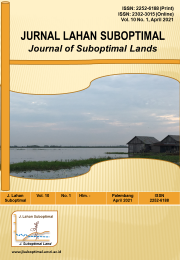Performance of New Superior Variety of Rice and its Feasibility in Rainfed Rice Lowland of South Sumatra
DOI:
https://doi.org/10.36706/JLSO.10.1.2021.546Keywords:
Inpari 30, Inpari 43 , IR 42, new superior variety , rain fed rice lowlandAbstract
Rainfed lowland has great potential to produce rice in South Sumatra Province. Rice cultivation in such marginal lowland needs technological innovation for sustainable use. This study aimed to analyze the crop performance and farming feasibility of a New Superior Variety (VUB) in rainfed rice cultivation. The study was carried out on 2019/2020 in Tugu Jaya Village, Lempuing District, OKI Regency. It was implemented in a demonstration plot of rice cultivation covering 2 hectares, using Inpari 30 and 43 varieties. The plant spacing was in accordance with 2:1 “jajar legowo” planting system. This was compared to the tile planting system outside the demonstration plot using IR 42 variety, which was planted by the local farmers. The results of observations of plants’ performance one day before harvest showed that the tallest plant was IR 42 (109.1 cm), the most tillers were from Inpari 43 (19.7 tillers), the longest panicle was of IR 42 (25.1 cm) and the highest harvested crop grain production was from Inpari 30 (6.8 tonnes/ha). In terms of business feasibility, judging from the resulting production and financial indicators, all three varieties were suitable for planting in rainfed lowland. Furthermore, of the three varieties, Inpari 30 on MH 2019/2020 was the most feasible, with a break-even price (BEPr) of Rp. 3,983 per kg; break-even production (BEP) of 1,568 kg per hectare; revenue cost ratio (R/C) of 2.39 and Marginal Benefit-Cost Ratio (MBCR) of 6.96.
References
Ardy D, Suswati D, Hazriani R. 2014. Characteristic of irrigated and rainfed rice land in Batu Ampar village, belimbing sub didtric, distric of Melawi. Jurnal Sains Mahasiswa Pertanian. 3(3): 1-7.
Central Bureau of Statistics (BPS), South Sumatra. 2016. Land area according to use in South Sumatra 2015. Central Bureau of Statistics South Sumatra: Palembang.
Chauhan JS, Prasad SR, Pal S, Choudhury PR. 2017. Seed systems and supply chain of rice in India. Journal of Rice Research. 10(1): 9-16.
Chaucan JS, Prasad SR, Pal S, Choudhury PR, Bhaskar KU. 2016. Seed production of field crops in India: quality assurance, status, impact and way forward. Indian Journal of Agricutural Sciences. 86(5): 563-579.
FAO. 2017. The future of food and agriculture-Trends and Challenges. FAO: Rome.
FAO. 2014. Building a common vision for sustainable food and agriculture. FAO: Rome.
Sahu RK, Sah RP, Sanghamitra P, Verma RL, Patil NKB, Jena M, Mukherjee AK, Bag MK, Singh ON. 2018. Quality Seed Production and Maintenance Breeding For Enhancing Rice Yield. In: Pathak et al. (eds.). Rice Research for Enhancing Productivity, Profitability and Climate Resilience. Icar-National Rice Research Institute, Cuttack, Odisha: India. p. 37-51.
Hendayana R. 2016. Analysis of Assessment Data. Agricultural Research and Development Agency, IAARD Press.
Hutapea Y, Waluyo. 2018. Farmers' perceptions of the innovation of new superior varieties of rice in OKU Regency, South Sumatra. In: Matindas et al. (Eds.), Prosiding Seminar Nasional Inovasi Pertanian Unggulan Daerah Mendukung Pencapaian Target Produksi Nasional. p. 507-516.
Jonharnas, Sitindaon SH. 2017. The role of rainfed areas for national food security at Deli Serdang district, North Sumatra. Jurnal Agroteknologi. 7(2): 15 – 20.
Kasno A, Rostaman T, Setyorini D. 2016. Increasing productivity of rainfed area with N, P, and K fertlizers and use of high yielding varieties. Jurnal Tanah dan Iklim. 40(2): 147-157.
Lailiyah N, Timisela NR, Kaplale R. 2017. Analysis of rainfed lowland rice (Oryza sativa L.) production in Lea Wai Village, North Seram Kobi District. Agrilan. 5(2): 151-165.
Mishra SK, Lipi D, Kumar GAK, Rath NC, Mondal B, Jambhulkar NN, Samal P, Sadangi BN, Pradhan SK, Saha S, Rath PC, Mukherjee AK, Sahu RK, Guru PK, Singh CV, Prasad SM, Bhagat S, Roy S, Bhagabati R, Saikia K. 2018. Innovative extension approaches for increasing income of rice farmers. In Pathak et al (Ed). Rice Research for Enhancing Productivity, Profitability and Climate Resilience. Icar-National Rice Research Institute, Cuttack, Odisha, India: p. 37-51.
Purwanto, Astuti DW, Subagio H. 2012. Accelerating the adoption of new superior varieties to increase productivity in East Java. In: Prosiding Seminar Nasional Kedaulatan Pangan dan Energi, Fakultas Pertanian Universitas Trunojoyo Madura. p. 7.
Sari MD, Harnisah H, Suparwoto S. 2017. Farm system feasibility of new prime variaty in rained rice field in Ogan Komering Ilir regency South Sumatera province. Jurnal Lahan Suboptimal : Journal of Suboptimal Lands. 6: 120-125
Sasmita P, Satoto, Rahmini, Agustiani N, Handoko DD, Suprihanto, Guswara A, Suharna. 2019. Description of New Superior Varieties of Rice. Agricultural Research and Development Agency, Ministry of Agriculture.
Syahri, Somantri RU. 2016. The Use of Improved varieties resistant to pests and diseases to increase national rice production. J. Litbang Pert. 35(1): 25-36.
Sudarwati S, Purnamasari M, Munawarah T. 2014. Evaluation of farmers' preferences on yield quality of several superior lowland rice varieties in Kutai. In: Satoto et al (Ed.). Prosiding Seminar Nasional 2013. Buku 1. p. 97-109.
Sukristiyonubowo S, Riyanto D, Widodo S. 2019. The influence of fertilizer technologies on soil quality, rice growth and biomass production of ciherang vareity cultivated in newly developed lowland rice fields of kleseleon, Malaka district. Jurnal Lahan Suboptimal : Journal of Suboptimal Lands 8: 1-10.
Suyamto. 2017. The benefit of organic matter and organic fertilizers for rice crop in irrigated rice land. Iptek Tanaman Pangan. 12(2): 67-74.
Wahyuni SET, Asngad A. 2017. Provision of liquid organic fertilizer for rice straw waste and chicken egg shell waste to increase the calcium content of the mustard plant (Brassica juncea, L.). In: Prosiding Seminar Nasional Pendidikan Biologi dan Saintek II.
Downloads
Published
How to Cite
Issue
Section
License
Copyright (c) 2021 Yeni E Maryana, Herwenita Herwenita, Y Hutapea

This work is licensed under a Creative Commons Attribution-NonCommercial-ShareAlike 4.0 International License.













